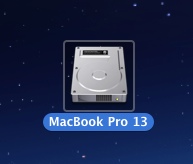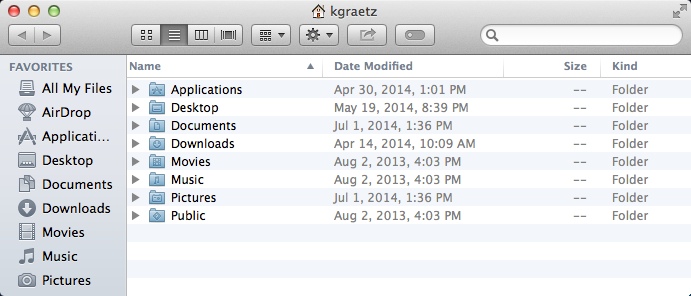Managing files on your Apple MacBook hard drive
NOTE: This article is under construction. --Ken Graetz (talk) 18:51, 6 July 2014 (CST)
About this article
This article includes instructions and suggestions for storing, organizing, and backing up files on your MacBook hard drive. It is intended for any student or employee with a MacBook.
Where are your files?
You have full administrative rights to your laptop. That means you have the ability to save your files just about anywhere on your laptop's hard drive. You may have saved things, intentionally or unintentionally, to locations other than the ones we configured as described below. It's up to you to find and manage those folders and files.
- On a MacBook, all of the space on the single hard drive is assigned to one partition called MacBook Pro/Air # where the number represents the year it was distributed (e.g., MacBook Pro 13). Open your hard drive by double-clicking the MacBook Pro/Air # drive icon on your desktop (Figure 1)
- To help you keep your files organized, WSU created some folders in your Home folder on your hard drive. You can open your Home folder by opening up your hard drive, opening up the Users folder, and opening the Home folder. It's the one with the icon that looks like a house and that is named with your username (Figure 2).
- Another way to get to your Home folder is to select the Go menu and select Home. This opens up the home folder and displays its contents.
- Inside your Home folder, you will find several sub-folders: Desktop, Documents, Downloads, Movies, Music, Pictures, and Public.
All WSU laptops have a default folder called Documents.
About the Applications folder
You may or may not have such a folder depending on what applications are installed on you MacBook. Don't confuse this Applications folder in your Home directory with the one that contains all of your installed applications. They are two different folders. This one simply stores personal data and files associated with certain applications. For example, the default storage location for the screen shots you capture using TechSmith SnagIt, a screen capture program, is a sub-folder in your Applications folder in your Home directory. The actual SnagIt application itself is stored in another location. For most applications, you can change their default save locations if you wish, but always check this Applications folder to see if there is anything in there you want to back up and retain.
About the Desktop folder
The Desktop folder in your Home directory contains all the folders, files, and shortcuts found out on your desktop. Some people like to store things, lots of things, right on their desktop. They save files, folders, and shortcuts to applications right out on the desktop. If this methods works for you and you want to replicated it on another MacBook, you will need to back up the Desktop folder and then copy and paste it to your Home directory on the other machine. Note that your shortcuts will not work on the new laptop if the applications they link to are not it the same place. The fastest way to restore them is to delete them and recreate them on the new laptop.
About the Downloads folder
This folder contains any application update, printer driver, or other software or hardware-related file you ever downloaded from the web. The vast majority of these files do not need to be retained because you will probably never use them again. However, this folder may also contain manuals, journal articles, image files, and other useful, downloaded documents or media that you do want to retain. Take a look through your Downloads folder regularly. Delete anything you don't need and move anything important to another folder to better organize it. Ideally, your Downloads folder should be empty.
Where your laptop folders and files might be stored
- Desktop folder
- Downloads folder

